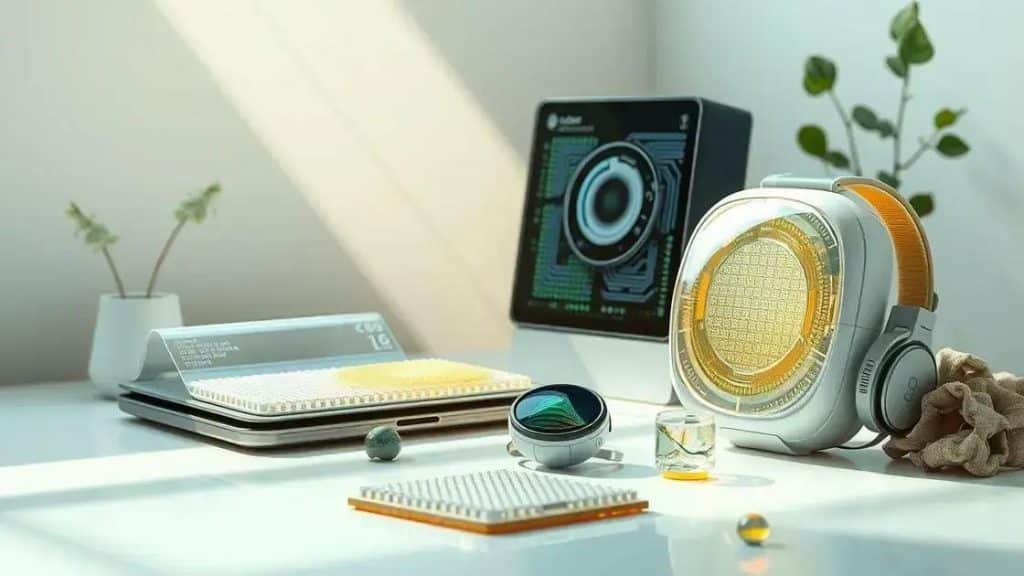Biodegradable semiconductor materials: a sustainable future

Biodegradable semiconductor materials offer sustainable alternatives in electronics by naturally decomposing after use, reducing waste and environmental impact while presenting challenges such as higher production costs and performance alignment with traditional semiconductors.
Biodegradable semiconductor materials are paving the way for a remarkable shift in technology. Imagine a world where electronic waste is minimized and sustainability is at the forefront of innovation. Let’s dive into how these materials can reshape our future.
Understanding biodegradable semiconductor materials
Understanding biodegradable semiconductor materials is key to navigating the future of technology. These materials are designed to break down naturally after their useful life, reducing electronic waste significantly. Unlike traditional semiconductors, which remain in landfills for years, biodegradable options offer a more sustainable solution.
What are biodegradable semiconductors?
Biodegradable semiconductors are made from organic materials that can decompose safely. Still leveraging performance in electronic devices, they can provide similar functionalities to their conventional counterparts. They are not only eco-friendly but also promote a new era of sustainability in electronics.
Benefits of using biodegradable materials
- Environmental protection by reducing waste.
- Enhanced sustainability in product design.
- Lowered costs associated with disposal and recycling.
This transition to biodegradable materials holds tremendous potential. Imagine a world where electronic devices won’t damage our environment. This shift is not just beneficial for ecology but also essential for a responsible future.
Additionally, these materials require less energy for production. For example, the eco-friendly processes involved in creating biodegradable semiconductors are less taxing on natural resources. By utilizing renewable sources, manufacturers can produce devices that align with growing environmental demands.
Applications in various sectors
Biodegradable semiconductors are making their mark in numerous industries. From consumer electronics to medical devices, their versatility is astounding. In healthcare, they can be implanted in the body, safely decomposing over time and eliminating the need for surgical removal.
- Consumer electronics, like biodegradable phones.
- Medical devices for temporary implants.
- Smart packaging that decomposes after use.
As researchers continue to innovate, the applications appear limitless. Understanding biodegradable semiconductor materials opens up a world of possibilities that could lead to more responsible production and consumption patterns.
Key applications in electronics and sustainability

Key applications of biodegradable semiconductor materials in electronics showcase their vast potential in promoting sustainability. These materials aren’t just a concept; they are becoming essential components in various technologies aiming to reduce environmental impact.
Consumer electronics
In the realm of consumer electronics, biodegradable semiconductors are being integrated into devices like smartphones and tablets. By using these materials, manufacturers can produce devices that will not contribute to landfill waste after their lifecycle ends. This innovation allows consumers to enjoy advanced technology while being environmentally responsible.
Medical devices
Biodegradable semiconductors also play a significant role in the medical field. They can be used in temporary implants that safely dissolve in the body over time. This reduces the need for additional surgeries to remove devices, making healthcare simpler and less invasive. The use of safe, natural materials in these technologies enhances patient outcomes and decreases the risk of complications.
- • Example of biodegradable sensors in diagnostics.
- • Use in drug delivery systems that dissolve after use.
- • Development of eco-friendly monitoring devices.
As we advance in electronics and sustainability, the applications extend beyond these industries. For instance, biodegradable semiconductors can be utilized in smart packaging solutions that decompose after their usage, reducing plastic pollution substantially. Such innovations are not merely beneficial but necessary for future sustainability.
Overall, the integration of biodegradable semiconductor materials supports an eco-friendly tech landscape. By combining high functionality with environmental responsibility, these materials present a win-win situation for consumers and the planet. As awareness grows, so will the adoption of these sustainable practices in various sectors.
Advantages of using biodegradable materials
Understanding the advantages of using biodegradable materials is essential in today’s eco-conscious world. These materials offer a variety of benefits that make them attractive for consumers and manufacturers alike. By prioritizing sustainability, we can foster a healthier planet.
Environmental benefits
One of the most significant advantages is their positive impact on the environment. Unlike traditional materials, biodegradable materials decompose naturally, reducing landfill waste. This means less pollution and a smaller carbon footprint. They also help to preserve biodiversity by minimizing the harmful effects of synthetic materials on ecosystems.
Economic savings
Using biodegradable materials can also lead to economic savings for companies. By reducing waste disposal costs, businesses can save money in the long run. Moreover, as consumer demand for sustainable products increases, companies that adopt biodegradable materials can enhance their market appeal and competitiveness.
- • Lower waste management costs.
- • Increased consumer interest in eco-friendly products.
- • Possibility of tax incentives for sustainable practices.
The health benefits of biodegradable materials are another crucial aspect to consider. They often use non-toxic compounds, making them safer for human health. Unlike conventional materials, which may leach harmful substances into the soil and water, biodegradable options do not pose these risks. This leads to safer environments for communities, especially in agricultural areas.
Also, biodegradable materials can offer versatility in design and application. Advances in technology have led to the creation of innovative biodegradable substances that can be tailored for specific uses. This allows for greater creativity and efficiency in product development, which can keep pace with market demands.
Challenges and future prospects in the sector

The challenges and future prospects in the sector of biodegradable semiconductor materials are evolving rapidly. While these materials present exciting opportunities, several hurdles need addressing as the industry continues to develop and expand. One challenge is production cost.
High production costs
Currently, the production of biodegradable materials can be more expensive than traditional semiconductors. This price difference can deter manufacturers from making a switch. As demand grows, economies of scale may help reduce these costs, making biodegradable options more attractive.
Material performance
Another critical challenge is ensuring that biodegradable semiconductors can match the performance of their conventional counterparts. Issues such as longevity and reliability must be resolved to gain consumer trust. Researchers are working on improving the durability and efficiency of these materials to meet industry standards.
- • Enhancing electrical conductivity.
- • Increasing lifespan without compromising biodegradability.
- • Developing new composites to boost performance.
Furthermore, consumer awareness plays a significant role in the adoption of biodegradable materials. Many consumers still do not fully understand the benefits of these products. Education and marketing efforts are vital to inform the public and highlight the advantages of sustainable technology.
As for future prospects, the rise in eco-consciousness globally is paving the way for innovation. With stricter regulations targeting waste and environmental impact, industries are increasingly looking for sustainable alternatives. This trend is expected to drive investment and research in biodegradable semiconductor technologies.
Collaboration among researchers, manufacturers, and governments can foster a more robust ecosystem for developing these materials. By working together, stakeholders can create solutions that meet both economic needs and environmental standards. Overall, the future for biodegradable semiconductors appears promising, as long as the industry can tackle the existing challenges effectively.
biodegradable semiconductor materials hold great promise for the future of technology and sustainability. They offer environmental and economic benefits while addressing the challenges posed by traditional materials. As awareness grows among consumers and industries, the demand for these innovative solutions will likely increase. Collaboration across sectors will be vital to overcome existing hurdles. The journey towards a more sustainable future is bright, especially with ongoing advancements in biodegradable technologies.
FAQ – Frequently Asked Questions about Biodegradable Semiconductor Materials
What are biodegradable semiconductor materials?
Biodegradable semiconductor materials are eco-friendly alternatives that decompose naturally and reduce electronic waste, making them more sustainable than traditional semiconductors.
What are the benefits of using biodegradable materials in electronics?
They significantly reduce waste, lower environmental impact, and can lead to cost savings for manufacturers while appealing to environmentally conscious consumers.
What challenges do biodegradable semiconductors currently face?
Key challenges include higher production costs, ensuring performance matches traditional options, and increasing consumer awareness about their benefits.
What is the future prospect of biodegradable semiconductor materials?
With growing demand for sustainable tech solutions, research and collaboration among industries are likely to drive innovation and adoption in the future.





